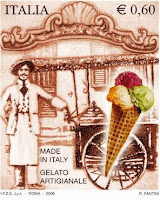 Today is the last day of March, and the Spring 2010 students officially have less than one month left in Perugia and at the Umbra Institute. Knowing how quickly this month will fly by, here are Umbra’s Top Five Must-Do’s before you leave…
Today is the last day of March, and the Spring 2010 students officially have less than one month left in Perugia and at the Umbra Institute. Knowing how quickly this month will fly by, here are Umbra’s Top Five Must-Do’s before you leave…5. Taste free chocolate at the Perugina factory.
Most of the Italian classes will be touring the home of the world-famous chocolate and hazelnut baci this week, but if you missed out, pick up a bus ticket and go on your own for a free tour and tasting!
4. Relax by the shore of Lago Trasimeno.
The biggest lake in central and south Italy, Lago Trasimeno is only an hour away from the center of Perugia by train. There are several sleepy towns around the lake with gelato and docks for relaxing, but the Umbra staff suggests going to Castiglione del Lago for its impressive views and historic center.
3. Walk through the “underground city,” over the Roman acqueduct, and into the Duomo. We walk past these landmarks around town everyday, but have you ever actually been inside? Perugia’s most interesting historical sites are all free and right here in the center: the Roman Acqueduct, the Etruscan Well, the Tempietto and Tower of Sant’Angelo, the Duomo, and the Rocca Paolina. Talk to Zack if you need help finding these spots.

2. Eat Pasta alla Norcina, Torta con Salsiccia ed Erba, and Hot Chocolate from Augusta Perusia! Pasta with Umbrian sausage and truffles, typical Umbria torta, and to-die-for hot chocolate… you can’t go home without trying these Perugia specialties.
1. Picnic in the grass on a sunny afternoon at San Francesco.
At the bottom of Via dei Priori you’ll find the church of San Francesco and the big grass lawn in front. Pick up sandwiches from Parma (another Perugia must-eat) and bring a blanket and your iPod… perfect for reading, catching up with friends, or meeting local Italian students.



 Her name is a little bit different in Italian, but that didn’t present any sort of linguistic barrier to the Umbra Institute students participating in a fundraiser for Unicef. The project involves sewing together rag dolls, which are then sold to raise money for hunger prevention and vaccinations in the developing world. Umbra intern Paola D’Amora coordinated the effort and organized the dozen Umbra students that work with Perugians to make the dolls. This is the second semester that Umbra students have been at the heart of the fundraiser, an accomplishment noted in several local newspapers.
Her name is a little bit different in Italian, but that didn’t present any sort of linguistic barrier to the Umbra Institute students participating in a fundraiser for Unicef. The project involves sewing together rag dolls, which are then sold to raise money for hunger prevention and vaccinations in the developing world. Umbra intern Paola D’Amora coordinated the effort and organized the dozen Umbra students that work with Perugians to make the dolls. This is the second semester that Umbra students have been at the heart of the fundraiser, an accomplishment noted in several local newspapers.





 Thousands of foreigners have passed through Perugia in the last century, and yet it’s hard to know what they thought about the city. Except for a few quotes from some of the more illustrious travelers of the recent past, the archives are empty. Umbra Institute staff member Zach Nowak decided to remedy this situation. Using his little publishing company, Nowak set up a contest for a Perugia anthology.
Thousands of foreigners have passed through Perugia in the last century, and yet it’s hard to know what they thought about the city. Except for a few quotes from some of the more illustrious travelers of the recent past, the archives are empty. Umbra Institute staff member Zach Nowak decided to remedy this situation. Using his little publishing company, Nowak set up a contest for a Perugia anthology.
